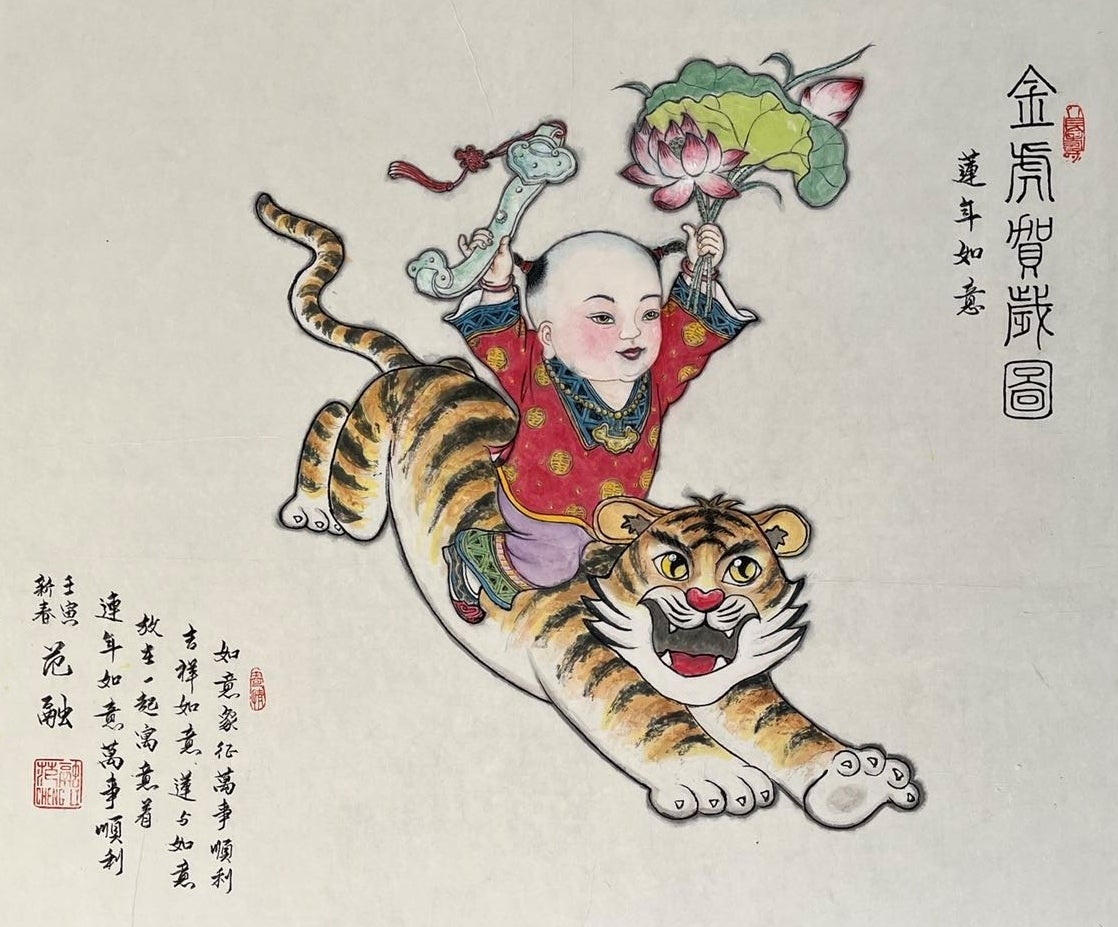ASU celebrates Lunar New Year, Chinese language education

Rong Fan, who teaches painting and calligraphy at the Contemporary Chinese School of Arizona, works on a painting in honor of Lunar New Year and the Year of the Tiger, which began Feb. 1.
Arizona State University's School of International Letters and Cultures, in partnership with the Contemporary Chinese School of Arizona and Phoenix Sister Cities, celebrated Lunar New Year last month with a virtual event that showcased the school’s Chinese program and its many connections within the local community.
“Arizona Chinese Language and Culture Experience Day 2022” brought together a variety of speakers to discuss Chinese language education in Arizona. The morning began with remarks from U.S. Rep. Greg Stanton, Jeffrey Cohen, dean of humanities in The College of Liberal Arts and Sciences, and Linda Burrows, Arizona Department of Education K–12 social studies and world languages specialist
They were followed by keynote addresses from Associate Professor of Chinese Lucas Klein and Theresa Chao, the chief editor of MeiZhou Chinese and former president of the National Council of Associations of Chinese Language Schools.
“I talked for a bit about my own experiences with studying Chinese and living in Chinese parts of the world — mainland China, Taiwan, Hong Kong — and the changes that these parts of the world have seen in the decades that I’ve been spending time there,” Klein said.
He explained that enrollment in Chinese language classes around the country has been declining amid changing views of the United States’ relationship to China. However, this shouldn’t prevent interested students from taking classes on Chinese language and culture. In fact, these shifting dynamics can even open new areas of study and provide more opportunities to engage with a complex country and its deep history and culture.
“It’s up to us to create a new story,” Klein said. “The point that I wanted to make is that China does not mean just one thingd — it never has — but rather represents a diversity of opinions and viewpoints. Hopefully that allows for the possibility of developing new stories to shape new reasons for studying Chinese.”
The education symposium concluded with a panel discussion featuring six Chinese language educators from a variety of institutions and instructional levels. That discussion was moderated by Associate Professor of Chinese Nicholas Williams. He and Klein were two of the event’s organizers, and this was their first time participating in it.
“One of the really special things about this event is the way that it spans the different academic levels, including both K–12 and university education in Chinese,” Williams said. “The roundtable discussion included people teaching at many different levels, so we talked about how to develop Chinese education and share the many opportunities that are available in Arizona already.”
After the panel came the language and culture fair, which included presentations of calligraphy, painting, instruments, food culture, martial arts and other cultural activities. Phoenix Sister Cities discussed the relationship between Phoenix and Chengdu, China, one of its sister cities. Chengdu, the capital of the Sichuan Province, has been affiliated with Phoenix since 1987. The sister cities relationship paves the way for political, economic and cultural exchanges between global cities.
During the culture fair, Rong Fan, who teaches painting and calligraphy at the Contemporary Chinese School of Arizona, created a painting in honor of Lunar New Year and the Year of the Tiger, which began Feb. 1.
Artist and teacher Rong Fan created this painting in honor of Lunar New Year and the Year of the Tiger during the recent "Arizona Chinese Language and Culture Experience Day 2022."
Although Lunar New Year is celebrated by many Asian countries and individuals of Asian descent, it is most commonly associated with Chinese culture. The first day of the new year begins on the new moon that appears between Jan. 21 and Feb. 20.
A common practice of Lunar New Year is for families to clean their houses in order to sweep away bad luck and welcome in good fortune. Red decorations are put up because the color also symbolizes good fortune. Families gather to feast together as well as honor their ancestors. Traditional gifts of money are given out in red envelopes; other common activities include dragon dances and setting off firecrackers.
Cultural celebrations such as Lunar New Year are an engaging entry point for prospective students to learn more about other languages and countries. People are often curious to discover more about the history and symbolism behind various traditions, and they may be inspired to get to know their local community or even study a new language.
“A big part of this for us is that we would like to promote SILC’s programs to high school students in Arizona and encourage them to consider majoring in Chinese, or joining the Chinese Flagship Program, or exploring the many other SILC programs,” Williams said.
More Arts, humanities and education

Professor's acoustic research repurposed into relaxing listening sessions for all
Garth Paine, an expert in acoustic ecology, has spent years traveling the world to collect specialized audio recordings.He’s been…

Filmmaker Spike Lee’s storytelling skills captivate audience at ASU event
Legendary filmmaker Spike Lee was this year’s distinguished speaker for the Delivering Democracy 2025 dialogue — a free…

Grammy-winning producer Timbaland to headline ASU music industry conference
The Arizona State University Popular Music program’s Music Industry Career Conference is set to provide students with exposure to…


